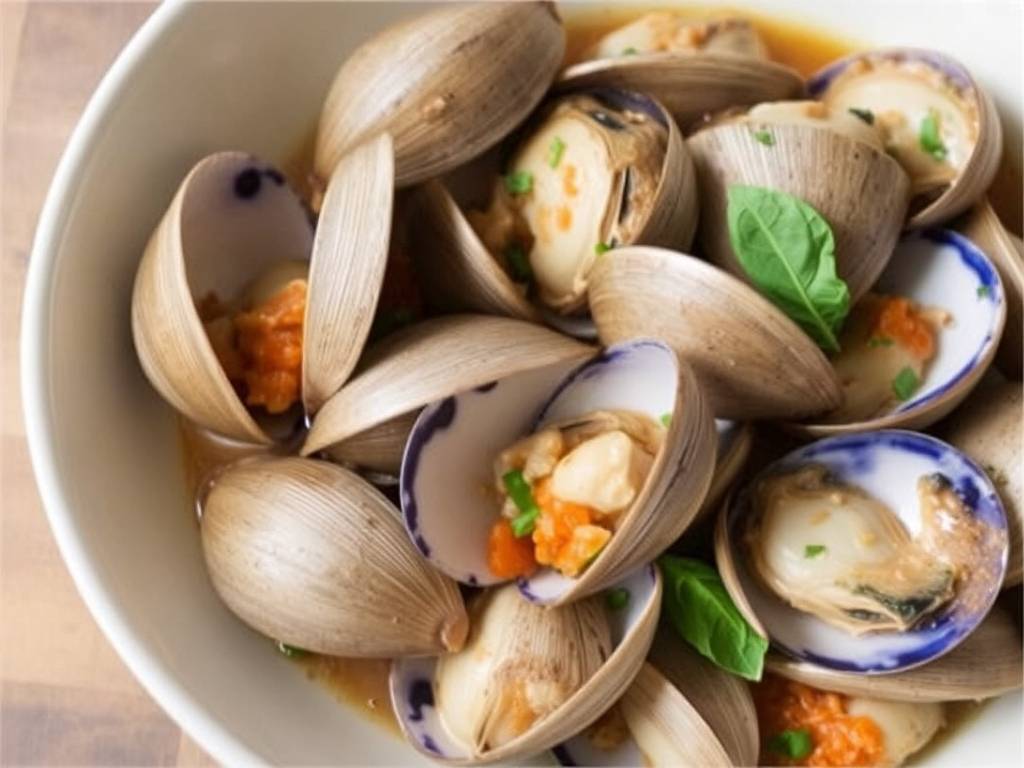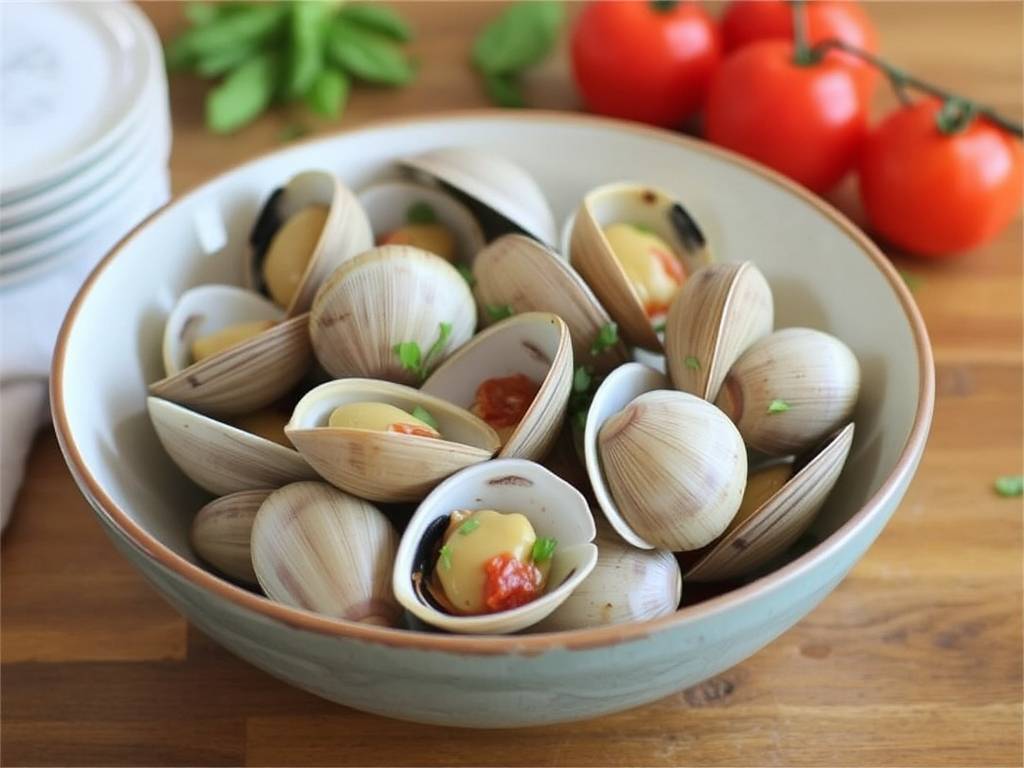A Taste of the Sea: Mastering Clams with Tomato and Basil Butter
There is a particular kind of magic that happens when the bounty of the sea meets the vibrant, sun-drenched flavors of a Mediterranean garden. It’s a culinary alchemy that transforms simple ingredients into a dish that feels both rustic and elegant, comforting and exciting. At the heart of this transformation lies the humble clam, a treasure of the tides, and its perfect partner: a luxuriously fragrant tomato and basil butter. This dish, Clams with Tomato and Basil Butter, is more than a recipe; it's an experience—a symphony of briny, sweet, acidic, and herbal notes played out in a single, steaming pot.
The beauty of this preparation is its deceptive simplicity. It requires no complex techniques or esoteric ingredients, yet the result is profoundly satisfying. It’s a dish that invites conversation, perfect for a casual dinner party where the centerpiece is a large, shared platter, or for a quiet, indulgent weeknight meal that transports you to a coastal Italian village. To achieve this perfection, however, one must begin with a deep respect for the core components.

The Star: Selecting and Preparing Your Clams
The undisputed star of this show is the clam. Not all clams are created equal for this particular preparation. Littlenecks and Manila clams are the ideal candidates. Their small to medium size ensures tender, quick-cooking meat, and their shells open beautifully to cradle the flavorful broth. Cherrystone clams can be used, but they are larger and chewier, requiring a slightly longer cooking time.
When purchasing clams, freshness is non-negotiable. Seek out a reputable fishmonger. Look for clams that are tightly closed or that close promptly when tapped. This is a sign of a live, healthy clam. Any with cracked or gaping shells that do not close should be discarded immediately.
Once home, the clams require a crucial step: purging. Clams are filter feeders and can harbor sand and grit inside their shells, which can ruin the texture of your final dish. Place the clams in a large bowl and cover them with cold, salted water (use about 1/3 cup of salt per gallon of water, mimicking seawater). Let them soak for 20-30 minutes. Some chefs advocate adding a handful of cornmeal to the water, believing the clams will ingest it and expel more sand. After soaking, scrub the shells vigorously with a stiff brush under cold running water to remove any external debris. Drain and they are ready for their culinary debut.
The Supporting Cast: Building the Flavor Foundation
While the clams are the headliner, the tomato and basil butter is the supporting cast that elevates them to stardom. Each ingredient plays a critical role.
- The Butter: Use high-quality, unsalted European-style butter if possible. Its higher fat content and richer flavor create a more unctuous, velvety sauce. The butter will be combined with other ingredients to form a compound butter, which will melt into a glorious emulsion with the clam liquor.
- The Tomato: We are not looking for a heavy tomato sauce here, but rather a bright, sweet acidity. The best choice is ripe, fresh cherry or grape tomatoes, halved or quartered. Their firm flesh holds its shape better than larger tomatoes, providing little bursts of flavor. In the off-season, high-quality sun-dried tomatoes (the oil-packed, soft variety), finely chopped, can be a fantastic, intensely flavored alternative.
- The Basil: Freshness is, again, paramount. Basil is a delicate herb whose complex flavor—simultaneously sweet, peppery, and slightly minty—is destroyed by prolonged cooking. We will use it in two ways: some will be incorporated into the compound butter to infuse its flavor throughout the dish, and a final handful will be added raw at the very end to provide a fresh, aromatic lift.
- The Aromatics: Garlic and shallots form the aromatic base. They should be minced finely so they melt into the sauce without overwhelming it with large, crunchy pieces. A pinch of crushed red pepper flakes is optional but highly recommended, as it introduces a subtle, warm heat that cuts through the richness of the butter.
- The Liquid: While the clams will release their own magnificent liquor, a splash of dry white wine, such as a Sauvignon Blanc or Pinot Grigio, adds another layer of acidity and complexity. The alcohol cooks off, leaving behind a rounded fruitiness that complements the seafood beautifully.
The Performance: The Art of Cooking the Clams
Now, we bring it all together. The process is swift, so have all your ingredients prepped and within arm's reach—what the French call mise en place.
-
Create the Compound Butter: In a small bowl, combine 4 tablespoons of softened butter with one minced garlic clove, a tablespoon of finely chopped fresh basil, and a pinch of salt and black pepper. Mix well. This can be done ahead of time and chilled, but bringing it to near room temperature before use is helpful.
-
Sauté the Aromatics: In a large, heavy-bottomed pot or Dutch oven with a tight-fitting lid, heat a tablespoon of olive oil over medium heat. Add one finely minced shallot and cook until translucent, about 2 minutes. Add 2-3 more minced garlic cloves and the crushed red pepper flakes, cooking for just 30 seconds until fragrant. Be vigilant—burned garlic is bitter and will spoil the dish.
-
Deglaze and Build the Base: Pour in 1/2 cup of dry white wine. Let it bubble and reduce by half, scraping any browned bits from the bottom of the pot. This step, deglazing, captures all the flavorful fond.
-
The Main Event: Add the cleaned, drained clams to the pot. Give them a good stir to coat them in the aromatic base. Dot the top of the clams with your prepared tomato and basil compound butter. Scatter your fresh cherry tomatoes (about 1 cup) over everything. Do not add any additional water or salt at this stage—the clams will provide both.
-
Steam to Perfection: Cover the pot tightly with the lid. Increase the heat to medium-high and allow the clams to steam. This should take 5-8 minutes. Resist the urge to constantly peek! You need the build-up of steam to cook the clams evenly. You’ll know they are done when you hear a gentle roaring sound and see that the majority of the shells have opened wide.
-
The Final Flourish: Remove the lid. The sight and smell will be intoxicating—a briny, buttery, herby steam rising from a pot of open clams in a vibrant, brothy sauce. Discard any clams that have remained stubbornly closed; they were dead before cooking and are not safe to eat. Take the pot off the heat. Tear a large handful of fresh basil leaves and stir them gently into the clams and sauce. The residual heat will wilt them perfectly, releasing their essential oils.
Serving the Symphony

Presentation is key to completing the experience. Carefully ladle the clams, along with every last drop of the incredible sauce, into deep, wide bowls. The sauce is the soul of the dish—a complex, briny, buttery, tomato-flecked nectar that demands to be sopped up.
This is where crusty, artisanal bread becomes not a side, but an essential tool. A warm, chewy baguette or a slice of rustic sourdough is perfect for diving into the bowl and capturing every last delicious drop. For a more substantial meal, serve the clams over a bed of angel hair pasta or creamy polenta, which will act as a wonderful canvas for the sauce.
A glass of the same crisp, dry white wine you used for cooking is the only appropriate beverage pairing. Its acidity will cleanse the palate between bites, preparing you for the next sublime spoonful.
Cooking clams with tomato and basil butter is a lesson in trusting quality ingredients and simple processes. It’s a dish that celebrates the immediacy of fresh seafood and the timeless pairing of tomato and basil. From the initial scrub of the shells to the final dip of bread into the fragrant broth, it is a journey of flavor that is as rewarding to create as it is to consume. So, gather your ingredients, embrace the process, and prepare to bring a taste of the sea, kissed by the sun and garden, directly to your table.






发表评论